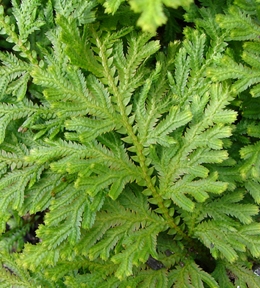Selaginella moellendorffii
Overview

Selaginella moellendorffii is a lycophyte that is an important
model organism, especially in comparative genomics.
S. moellendorffii is a member of an ancient vascular plant lineage that
first appear in the fossil record some 400 million years ago.
They would later form a dominant part of the world's flora during the
Carboniferous era. These lycopsids lack true leaves
(having microphylls instead) and roots and thus represent an important
node on the plant evolutionary tree. As the oldest extant division of the
vascular plants, they are essential to understanding the evolution of plants
as a whole.
The nuclear genome size is approximately 100 mega base pairs,
the smallest genome size found for any plant species.
The genome has been sequenced and assembled by the
DOE Joint Genome Institute. Community annotation of the genes and other
elements of this genome began in September 2007. See the website, below,
for more information on how to contribute to this effort.
The Joint Genome Institute provides these data in good faith,
but makes no warranty, expressed or implied, nor assumes any legal liability
or responsibility for any purpose for which the data are used.
By accessing these data, you agree not to publish any articles containing
analyses of genes or genomic data on a whole genome or chromosome scale prior
to publication by JGI and its collaborators of its comprehensive genome
analysis.
Further reading:
The Selaginella genome identifies genetic changes associated with the evolution of vascular plants. Science 332(6032), 960-3 (2011) [pubmed]
- Source
- JGI 1.0
- PLAZA identifier
- smo
- NCBI link
- Selaginella moellendorffii
- Mitochondrion
- Not available
- Chloroplast
- Not available
Toolbox
Various
- PLAZA download section
- Explore functional clusters
- Documentation data content
- View organism in the Genomeview or in the AnnoJ genome browser.
- View Selaginella moellendorffii specific or enriched gene families

Loading...please wait

Loading...please wait

Loading...please wait












